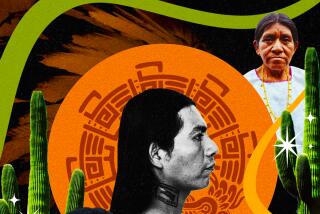Photo Essay : Snapshots From an Ancient Culture
- Share via
How do you document a centuries-old culture without a written language?
Sometimes the answer is all around you.
That’s what teen-agers in Mexico’s Totontepec village recently discovered when they became “cultural journalists,” tape-recording and photographing their families and neighbors--descendants of the ancient Mixe people. The Mixes, numbering about 100,000, are among more than 50 indigenous peoples who inhabit Mexico.
Financed by Oaxaca state, by the local Kong Oy Mixe Community Institute and by donations from U.S. foundations, 18 students spent five months studying local crafts, religious symbols and legends in their isolated farming village (population 1,800) in the mountains of Oaxaca. The project was coordinated by Laura Vargas Diaz of Oaxaca city and her husband, photographer Jeff Share.
The students made soap from ashes, lard and plants. They photographed basket weaving, traditional cooking and agriculture. In the nearby forest, they found the image of a serpent, believed to be revered by the pre-Hispanic culture, carved into rock.
Fast-forwarding to modern technology, the teen-agers stored their data on computers and produced 17 articles using a new alphabet devised by Margarita Cortez and other local linguists to write down their native language, called Ayuuk. The articles and 50 photographs were exhibited earlier this year at Oaxaca’s State Department of Education.
The students are now training others to produce a bilingual community publication to continue the work of creating a living record of the Mixe culture.
More to Read
Sign up for Essential California
The most important California stories and recommendations in your inbox every morning.
You may occasionally receive promotional content from the Los Angeles Times.













